Most Competitive Power Systems MCQs – Updated Symmetrical Components MCQs ( Power Systems ) MCQs
Latest Power Systems MCQs
By practicing these MCQs of Symmetrical Components MCQs ( Power Systems ) MCQs – Latest Competitive MCQs , an individual for exams performs better than before. This post comprising of objective questions and answers related to “ Symmetrical Components MCQs ( Power Systems ) Mcqs “. As wise people believe “Perfect Practice make a Man Perfect”. It is therefore practice these mcqs of Power Systems to approach the success. Tab this page to check ” Symmetrical Components MCQs ( Power Systems )” for the preparation of competitive mcqs, FPSC mcqs, PPSC mcqs, SPSC mcqs, KPPSC mcqs, AJKPSC mcqs, BPSC mcqs, NTS mcqs, PTS mcqs, OTS mcqs, Atomic Energy mcqs, Pak Army mcqs, Pak Navy mcqs, CTS mcqs, ETEA mcqs and others.
Power Systems MCQs – Symmetrical Components MCQs ( Power Systems ) MCQs
The most occurred mcqs of Symmetrical Components MCQs ( Power Systems ) in past papers. Past papers of Symmetrical Components MCQs ( Power Systems ) Mcqs. Past papers of Symmetrical Components MCQs ( Power Systems ) Mcqs . Mcqs are the necessary part of any competitive / job related exams. The Mcqs having specific numbers in any written test. It is therefore everyone have to learn / remember the related Symmetrical Components MCQs ( Power Systems ) Mcqs. The Important series of Symmetrical Components MCQs ( Power Systems ) Mcqs are given below:
Symmetrical Component Transformation – 1
1. The receiving end active power for a short transmission line is (where the angles have their usual meanings)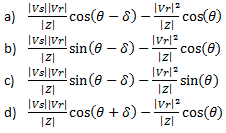
Answer: a
Explanation: Receiving end active power for a short transmission line is![]()
2. The receiving end reactive power for a short transmission line is (where the angles have their usual meanings)
Answer: c
Explanation: Receiving end reactive power for a short transmission line is![]()
3. The sending end active power for a 20 km transmission line with Vs as the sending end voltage and Vr as receiving end voltage, can be given by most appropriately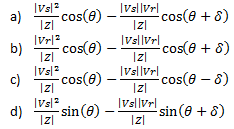
Answer: a
Explanation: The sending end active power is ![]()
4. The sending end reactive power for a 20 km transmission line with Vs as the sending end voltage and Vr as receiving end voltage, can be given by most appropriately
Answer: d
Explanation: The sending end reactive power is ![]()
5. The simplified ABCD representation of a 40 km transmission line is best given as
Answer: a
Explanation: From the given length, it is a short TL. Hence,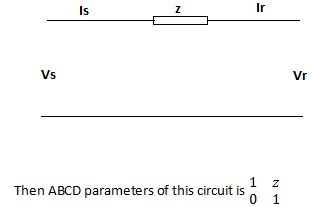
6. For a 35 km transmission line having a lumped impedance of the line as 20 ohms, is required to be shown in the ABCD form, it is given as
Answer: a
Explanation: From the given length, it is a short TL. Hence,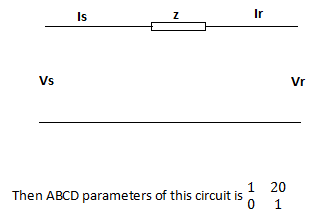
7. If it is tried to represent the active and reactive power on a circle, then the radius would be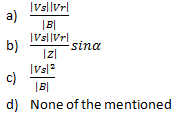
Answer: a
Explanation: 
8. The maximum power delivered to the load for short transmission line is at
a) β=α
b) β>α
c) β=δ
d) β>δ
Answer: c
Explanation: Maximum power occurs for β=δ.
9. The maximum real active power delivered to the load is defined most accurately by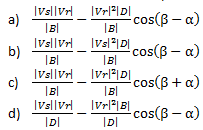
Answer: a
Explanation: The maximum real active power delivered to the load is ![]()
10. For a given power system, its zero and maximum regulation will occur at the impedance angle of
a) 45
b) 90
c) 0
d) 60
Answer: a
Explanation: At θ=45°, ZVR and maximum VR coincide.
11. The charging currents due to shunt admittance can be neglected for ______ transmission line?
a) short
b) long
c) medium
d) all of the mentioned
Answer: a
Explanation: The shun admittance for lines more than 100 km become very prominent and can not be neglected.
12. The transmission line equations are given by the below set of equations based on the line diagram as given. Identify the missing term marked as ’?’.
Vs = ?*Vr+B*Ir
Is = C*Vr+D*Ir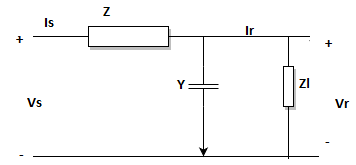
a) 1+YZ
b) Z
c) Y
d) 1
Answer: a
Explanation: Using KVL to the line diagram,
Vs = (1+YZ)*Vr+Z*Ir
Is = Y*Vr+Ir.
13. The transmission line equations are given by the below set of equations based on the line diagram as given. Identify the missing term marked as ’?’.
Vs = A*Vr+?*Ir
Is = C*Vr+D*Ir
a) 1+YZ
b) Z
c) Y
d) 1
Answer: b
Explanation: Using KVL to the line diagram,
Vs = (1+YZ)*Vr+Z*Ir
Is = Y*Vr+Ir.
14. The transmission line equations are given by the below set of equations based on the line diagram as given. Identify the missing term marked as ’?’.
Vs = A*Vr+B*Ir
Is = ?*Vr+D*Ir
a) 1+YZ
b) Z
c) Y
d) 1
Answer: c
Explanation: Using KVL to the line diagram,
Vs = (1+YZ)*Vr+Z*Ir
Is = Y*Vr+Ir.
15. The transmission line equations are given by the below set of equations based on the line diagram as given. Identify the missing term marked as ’?’.
Vs = A*Vr+B*Ir
Is = C*Vr+?*Ir
a) 1+YZ
b) Z
c) Y
d) 1
Answer: d
Explanation: Using KVL to the line diagram,
Vs = (1+YZ)*Vr+Z*Ir
Is = Y*Vr+Ir.
Symmetrical Component Transformation – 2
1. The transmission line equations are given by the below set of equations based on the line diagram as given. Identify A and B parameters.
Vs = A*Vr+B*Ir
Is = C*Vr+D*Ir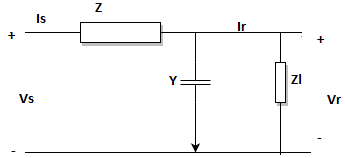
a) 1+YZ, Z
b) Z,Y
c) Y, 1+YZ
d) 1+YZ, Y-1+Z
Answer: a
Explanation: Using KVL to the line diagram,
Vs = (1+YZ)*Vr+Z*Ir
Is = Y*Vr+Ir.
Symmetrical Fault Analysis MCQs
2. The transmission line equations are given by the below set of equations based on the line diagram as given. Identify A and C parameters.
Vs = A*Vr+B*Ir
Is = C*Vr+D*Ir
a) 1+YZ, Z
b) Z,Y
c) 1+YZ, Y
d) 1+YZ, Y-1+Z
Answer: c
Explanation: Using KVL to the line diagram,
Vs = (1+YZ)*Vr+Z*Ir
Is = Y*Vr+Ir.
3. The transmission line equations are given by the below set of equations based on the line diagram as given. Identify A and D parameters.
Vs = A*Vr+B*Ir
Is = C*Vr+D*Ir
a) 1+YZ, 1
b) 1+YZ, Z
c) Y, 1+YZ
d) 1+YZ, Y-1+Z
Answer: a
Explanation: Using KVL to the line diagram,
Vs = (1+YZ)*Vr+Z*Ir
Is = Y*Vr+Ir.
4. The transmission line equations are given by the below set of equations based on the line diagram as given. Identify B and A parameters.
Vs = A*Vr+B*Ir
Is = C*Vr+D*Ir
a) 1+YZ, Z
b) Z,YZ+1
c) Z, 1+YZ
d) 1+YZ, Y-1+Z
Answer: b
Explanation: Using KVL to the line diagram,
Vs = (1+YZ)*Vr+Z*Ir
Is = Y*Vr+Ir.
5. The transmission line equations are given by the below set of equations based on the line diagram as given. Identify C and A parameters.
Vs = A*Vr+B*Ir
Is = C*Vr+D*Ir
a) 1+YZ, Z
b) Z,Y
c) Y, 1+YZ
d) 1+YZ, Y-1+Z
Answer: c
Explanation: Using KVL to the line diagram,
Vs = (1+YZ)*Vr+Z*Ir
Is = Y*Vr+Ir.
6. The transmission line equations are given by the below set of equations based on the line diagram as given. Identify D and A parameters.
Vs = A*Vr+B*Ir
Is = C*Vr+D*Ir
a) 1+YZ, Z
b) 1+ZY, 1
c) Y, 1+YZ
d) 1, 1+YZ
Answer: a
Explanation: Using KVL to the line diagram,
Vs = (1+YZ)*Vr+Z*Ir
Is = Y*Vr+Ir.
7. The transmission line equations are given by the below set of equations based on the line diagram as given. Identify A and B parameters and find AB value.
Vs = A*Vr+B*Ir
Is = C*Vr+D*Ir
a) (1+YZ)* Z
b) 1+YZ* Z
c) Y*( 1+YZ)
d) (1+YZ)*Y-1+Z
Answer: a
Explanation: Using KVL to the line diagram,
Vs = (1+YZ)*Vr+Z*Ir
Is = Y*Vr+Ir.
8. The transmission line equations are given by the below set of equations based on the line diagram as given. Identify A and B parameters and find ‘A*C’ value.
Vs = A*Vr+B*Ir
Is = C*Vr+D*Ir
a) (1+YZ)* Y
b) (1+YZ)* Z
c) Y*( 1+YZ)
d) (1+YZ)*Y-1+Z
Answer: a
Explanation: Using KVL to the line diagram,
Vs = (1+YZ)*Vr+Z*Ir
Is = Y*Vr+Ir.
9. The transmission line equations are given by the below set of equations based on the line diagram as given. Identify A and B parameters and find ‘A*D’ value.
Vs = A*Vr+B*Ir
Is = C*Vr+D*Ir
a) (1+YZ)
b) (1+YZ)* Z
c) 1
d) 0
Answer: a
Explanation: Using KVL to the line diagram,
Vs = (1+YZ)*Vr+ Z*Ir
Is = Y*Vr + Ir
AD = (1+YZ).
10. The transmission line equations are given by the below set of equations based on the line diagram as given. Identify A and B parameters and find ‘B*D’ value.
Vs = A*Vr+B*Ir
Is = C*Vr+D*Ir
a) (1+YZ)
b) (1+YZ)* Z
c) Z
d) YZ
Answer: c
Explanation: Using KVL to the line diagram,
Vs = (1+YZ)*Vr + Z*Ir
Is = Y*Vr + Ir
BD = Z.
11. The transmission line equations are given by the below set of equations based on the line diagram as given. Identify A and B parameters and find ‘B*C’ value.
Vs = A*Vr + B*Ir
Is = C*Vr + D*Ir
a) (1+YZ)
b) (1+YZ)* Z
c) 1
d) YZ
Answer: a
Explanation: Using KVL to the line diagram,
Vs = (1+YZ)*Vr+Z*Ir
Is = Y*Vr+Ir
BC = YZ.
12. The transmission line equations are given by the below set of equations based on the line diagram as given. Identify A and B parameters and find ‘C*D’ value.
Vs = A*Vr+B*Ir
Is = C*Vr+D*Ir
a) (1+YZ)
b) (1+YZ)* Z
c) Z
d) Y
Answer: a
Explanation: Using KVL to the line diagram,
Vs = (1+YZ)*Vr+Z*Ir
Is = Y*Vr+Ir
CD = Y*1 = Y.
13. The transmission line equations are given by the below set of equations based on the line diagram as given. Identify A and B parameters and find ‘AB-CD’ value.
Vs = A*Vr+B*Ir
Is = C*Vr+D*Ir
a) Z-Y+YZ2
b) (1+YZ)* Z
c) 1+YZ+YZ2
d) 1-YZ+ZY2
Answer: a
Explanation: Using KVL to the line diagram,
Vs = (1+YZ)*Vr+Z*Ir
Is = Y*Vr+Ir
AB-CD = (1+YZ)*Z-Y.
14. The transmission line equations are given by the below set of equations based on the line diagram as given. Identify A and B parameters and find ‘AD-BC’ value.
Vs = A*Vr+B*Ir
Is = C*Vr+D*Ir
a) Z-Y+YZ2
b) (1+YZ)* Z
c) YZ+YZ2
d) 1
Answer: d
Explanation: Using KVL to the line diagram,
Vs = (1+YZ)*Vr+Z*Ir
Is = Y*Vr+Ir
AD-BC = (1+YZ)-YZ = 1.
15. The transmission line equations are given by the below set of equations based on the line diagram as given. Identify A and B parameters and find ‘A*C*D’ value.
Vs = A*Vr+B*Ir
Is = C*Vr+D*Ir
a) ZY+(YZ)2
b) (1+YZ)* Z
c) YZ+YZ2
d) 1-YZ+ZY2
Answer: a
Explanation: Using KVL to the line diagram,
Vs = (1+YZ)*Vr+Z*Ir
Is = Y*Vr+Ir
ACD = (1+YZ)*ZY.
